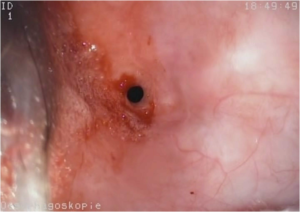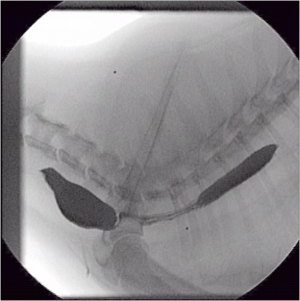Oesophageal Stricture
| This article is still under construction. |
Description
An oesophageal stricture is an abnormal circumferential narrowing of the oesophageal lumen secondary to severe oesophagitis. Deep injuries to the oesophageal wall heal by fibrosis which contracts over time to form the stricture. Animals may suffer from multiple strictures and the most common sites are within the distal high pressure zone (close to the lower oesophageal spincter), over the base of the heart and at the thoracic inlet. The oesophagus is narrower at these points and foreign bodies and refluxed ingesta are therefore more likely to accumulate at these locations. The most important causes of strictures include:
- Physical Injury
- Ingestion of foreign bodies which lodge in the oesophagus.
- Passage of nasogastric or pharyngostomy feeding tubes or of large endoscopes.
- Erosion of the oesophageal wall by neoplasia or abscesses.
- Surgical wounds to the oesophagus that heal with a fibrous component.
- Chemical Injury
- Gastro-oesophageal reflux, which may occur with general anaesthesia or hiatal hernias.
- Chronic vomiting
- Ingestion of caustic or irritant substances, including doxycycline in cats.
Signalment
The signalment is dependent on the underlying cause of the injury, with animals of all ages having the potential to be affected. 46% of cases occur after general anaesthesia, presumably due to gastro-oesophageal reflux through the relaxed lower oesophageal sphincter and because peristalsis and saliva production are reduced, meaning that refluxed material is not removed or neutralised.
Diagnosis
Clinical Signs
The signs observed depend on the severity and extent of the stricture but include:
- Regurgitation shortly after feeding, often with hypersalivation/ptyalism. Liquid foods may be better tolerated than solid food and it is better able to pass through the stricture.
- Anorexia and resultant weight loss.
- As with any cause of repeated regurgitation, aspiration pneumonia may develop with signs of coughing, tachypnoea, dyspnoea and pyrexia.
Diagnostic Imaging
Fibrosing strictures must be differentiated from vascular ring anomalies, oesophagitis, intraluminal and extraluminal masses. This can be done with survey and contrast radiography, endoscopy and ultrasonography.
Survey radiographs are usually unremarkable in animals with benign oesophageal strictures. Barium contrast radiography is normally diagnostic of the disorder and may demonstrate:
- Segmental or diffuse narrowing of the oesophagus
- Oesphageal dilatation proximal to the site of the stricture
Ultrasonography is not usually useful in diagnosing small benign strictures but may visualise those caused by mass compression.
Oesophagoscopy is used for a definitive diagnosis. It should be used to confirm the site and severity of the stricture and also to exclude the presence of an intraluminal mass.
Treatment
The suspected cause (ie.oesophagitis) should be corrected first. Oral feedings should be withdrawn in patients with severe stricture or oesophagitis. An oesophagostomy tube may be placed in these cases to provide nutritional support.
Medical therapies:
- Gastroprotective Drugs
- Oral sucralfate
- Gastric acid secretory inhibitors (cimetidine, ranitidine, omeprazole)
- Anti-inflammatory doses of corticosteroids (ie. prednisolone) to prevent fibrosis and re-stricture.
Surgical therapies:
- Dilation/widening of the stricture by ballooning or bougienage.
- Surgical resection is not recommended because iatrogenic strictures at the anastomotic site are possible.
Prognosis
The shorter the length of oesophagus involved and the quicker the corrective procedure is performed the better the prognosis. Animals with large, mature strictures and those with continued oesophagitis have a guarded prognosis. Long term gastrostomy tubes may be required in some cases.
References
- Hall, E.J, Simpson, J.W. and Williams, D.A. (2005) BSAVA Manual of Canine and Feline Gastroenterology (2nd Edition) BSAVA
- Merck & Co (2008) The Merck Veterinary Manual
- Nelson, R.W. and Couto, C.G. (2009) Small Animal Internal Medicine (Fourth Edition) Mosby Elsevier.

